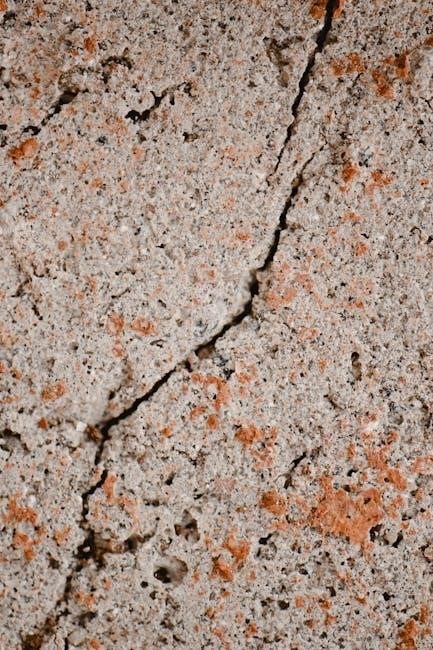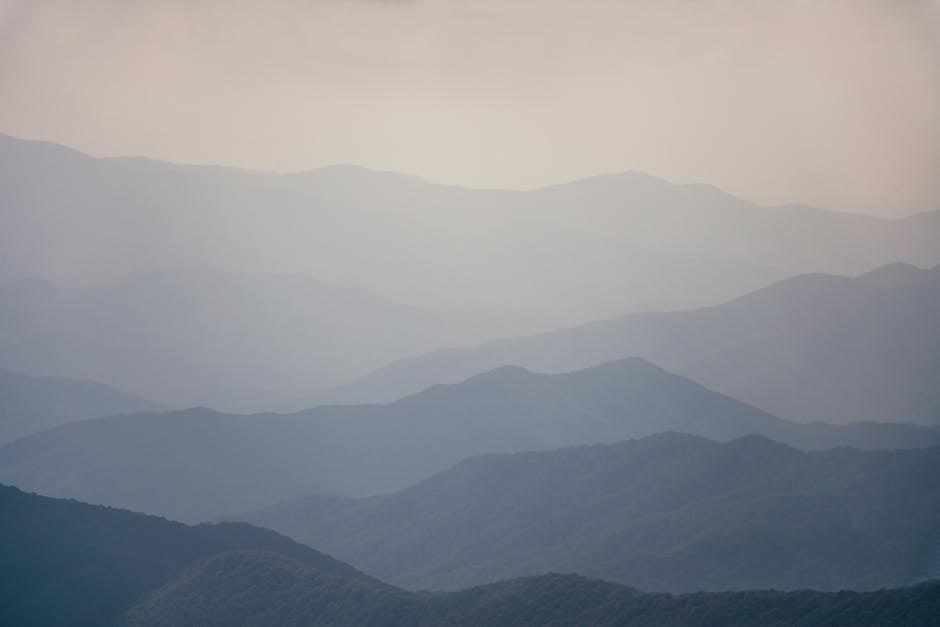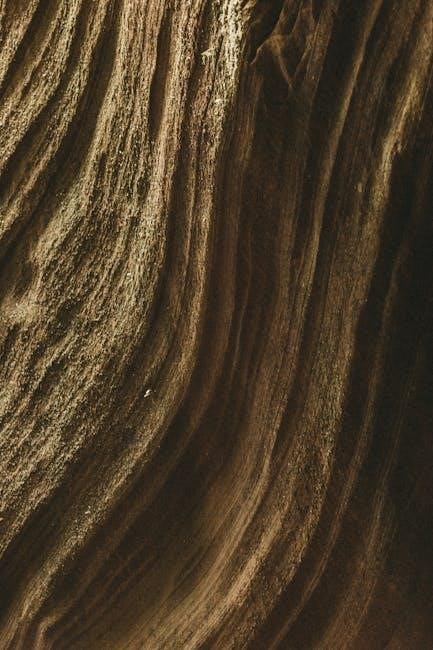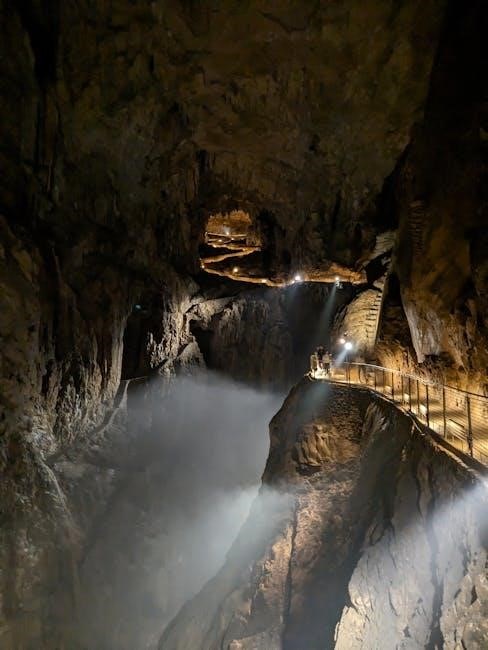The Earth’s structure comprises four distinct layers: crust, mantle, outer core, and inner core. Worksheets help students visualize and understand these layers through interactive exercises and diagrams, fostering a deeper appreciation of geological processes and Earth’s composition while catering to various educational levels.
1.1 Overview of the Earth’s Structure
The Earth is structured into four primary layers: the crust, mantle, outer core, and inner core. Each layer varies in thickness, composition, and physical state, with the crust being the outermost solid layer, the mantle beneath it, and the core divided into liquid and solid parts. Worksheets and educational tools simplify this complex structure, helping students visualize and understand the Earth’s composition through interactive diagrams and exercises.
1.2 Importance of Understanding Earth’s Layers
Understanding Earth’s layers is crucial for exploring natural resources, predicting geological events, and environmental monitoring. It helps in comprehending processes like earthquakes and volcanoes, which impact human lives. Educational tools, such as worksheets, simplify complex concepts, making them accessible for students. These resources foster a deeper appreciation of Earth’s internal structure, encouraging STEM interest and practical applications in geology and Earth sciences.

The Four Main Layers of the Earth
The Earth is divided into four primary layers: crust, mantle, outer core, and inner core. Each layer has unique characteristics, thickness, and composition, essential for understanding Earth’s structure and processes.
2.1 Crust: The Outermost Layer
The crust is the Earth’s outermost layer, ranging in thickness from 5 to 70 kilometers. It is composed of rocks, minerals, and sediment, varying between continental and oceanic crust. Continental crust is thicker and older, while oceanic crust is thinner and denser. The crust is brittle and fragmented into tectonic plates, which move and shape Earth’s surface. Worksheets often include diagrams to illustrate these differences, helping students understand the crust’s role in geological processes and its impact on landforms and ecosystems.
2.2 Mantle: The Thick Layer Below the Crust
The mantle is the Earth’s thickest layer, extending from 35 to 2,900 kilometers in depth. Composed primarily of silicate minerals like olivine and pyroxene, it makes up about 84% of the Earth’s volume. The mantle is divided into the upper and lower mantle, with increasing temperature and pressure. Its viscous, plastic-like flow drives plate tectonics. Worksheets often highlight the mantle’s role in geological activity, such as earthquakes and volcanoes, emphasizing its dynamic nature and importance in shaping Earth’s surface over time.
2.3 Outer Core: The Liquid Layer
The outer core is a liquid layer, approximately 2,250 kilometers thick, composed mostly of iron and nickel. It surrounds the solid inner core and plays a crucial role in generating Earth’s magnetic field through the movement of molten metal. This layer’s liquid state allows for convection currents, influencing geophysical phenomena like Earth’s magnetic field and plate tectonics. Worksheets often emphasize the outer core’s dynamic nature and its significance in Earth’s geophysical processes, making it a key focus in geological studies and educational materials.
2.4 Inner Core: The Solid Center
The inner core is Earth’s solid, central layer, with a thickness of about 1,500 kilometers. Composed primarily of iron and nickel, it remains solid despite extreme temperatures due to immense pressure. This layer is crucial for generating Earth’s magnetic field when combined with the outer core’s liquid motion. Worksheets often highlight its role in stabilizing the planet and its unique physical properties, making it a fascinating subject in Earth science education and geological studies.

The Earth’s Crust
The Earth’s crust is the outermost layer, ranging in thickness from 5 to 40 kilometers. It is composed of rocks, minerals, and sediments, forming the foundation of continents and ocean floors. Worksheets often include diagrams to differentiate between continental and oceanic crust, helping students understand its composition and role in geological processes.
3.1 Continental vs. Oceanic Crust
The Earth’s crust is divided into continental and oceanic crust. Continental crust is thicker, averaging 40 km, and is composed of granite-like rocks. Oceanic crust is thinner, around 5-10 km, and is denser with basaltic composition. Worksheets often highlight these differences, emphasizing their distinct compositions, thicknesses, and locations, with continental crust underlining landmasses and oceanic crust forming the sea floor.

The Mantle
The mantle is the Earth’s thickest layer, primarily composed of hot, viscous rock. Worksheets often feature diagrams and exercises to help students explore its composition and role in geological processes, making complex concepts engaging for learners.
4.1 Composition and Characteristics
The mantle is primarily composed of silicate minerals like olivine and pyroxene, forming a thick, viscous layer beneath the crust. It is divided into the upper and lower mantle, with the upper section being partially molten and the lower section solid. The mantle’s composition varies in density and temperature, with increasing heat and pressure at greater depths. Its fluidity over long timescales drives plate tectonics and convection currents, shaping Earth’s surface. Worksheets often include diagrams and exercises to help students visualize and explore these complex characteristics effectively.
4.2 The “Peanut Butter Sandwich” Analogy
The “peanut butter sandwich” analogy simplifies the Earth’s structure, comparing the crust, mantle, and outer core to a sandwich. The crust is like the bread, thin and outermost, while the mantle acts as the thick, viscous peanut butter filling. The outer core represents the jelly, a liquid layer beneath. This analogy helps students visualize the Earth’s layers, making complex concepts more relatable and easier to understand through engaging visual comparisons in educational worksheets.
The Outer Core
The outer core is a liquid layer, primarily composed of iron and nickel, located between the mantle and inner core. It generates Earth’s magnetic field through the movement of molten iron, essential for navigation and protecting the planet from solar radiation, with temperatures ranging from 4,000°C to 6,000°C at depths of 2,250 to 6,350 kilometers.
5.1 Liquid State and Magnetic Field
The outer core is a liquid layer composed primarily of iron and nickel, with temperatures ranging from 4,000°C to 6,000°C at depths of 2,250 to 6,350 kilometers. Its liquid state allows for fluid motion, which generates Earth’s magnetic field through a process known as the geodynamo. This magnetic field is vital for navigation, communication, and protecting the planet from harmful solar radiation. The outer core’s liquid composition and dynamic movement are essential for maintaining Earth’s magnetic properties and geological activity.

The Inner Core
The inner core is Earth’s solid center, composed of iron and nickel, with extreme temperatures and pressures. It plays a crucial role in Earth’s magnetic field.
6.1 Solid State and Extreme Temperatures
The inner core exists in a solid state due to immense pressure and extreme temperatures, estimated to reach over 5,000°C. Composed primarily of iron and nickel, it maintains its structure despite these conditions. The solid core is crucial for generating Earth’s magnetic field, which protects the planet from harmful solar radiation. Worksheets often highlight these extreme conditions to help students grasp the core’s unique role in Earth’s geophysical processes and overall stability.
How Scientists Study Earth’s Interior
Scientists study Earth’s interior using seismic waves, gravitational measurements, and magnetic field data; These methods, along with laboratory experiments, reveal the composition and structure of inner layers, while worksheets help students engage with these concepts effectively.
7.1 Methods Beyond Drilling
Scientists use seismic waves from earthquakes, gravitational measurements, and magnetic field data to study Earth’s interior. These methods reveal density variations and composition without physical samples. Lab experiments simulate high-pressure conditions, while advanced imaging techniques create detailed models. Worksheets help students visualize these methods, teaching how indirect observations uncover Earth’s structure. Such approaches are essential since direct drilling is limited, making these techniques vital for understanding the planet’s hidden layers effectively.
The Lithosphere and Its Relation to the Crust
The lithosphere is the outermost solid layer of the Earth, comprising the crust and the uppermost part of the mantle. It is fragmented into tectonic plates that move, shaping Earth’s surface. The crust is the lithosphere’s outermost component, varying in thickness under continents and oceans. Worksheets often highlight this relationship, helping students understand how the lithosphere’s dynamics influence geological phenomena like earthquakes and volcanoes, while emphasizing the crust’s role as the Earth’s surface layer.
Worksheet Activities
Engage with Earth’s layers through interactive worksheets, labeling diagrams, and comparative exercises. Ideal for grades 1-5, these activities simplify complex concepts, fostering hands-on learning and exploration.
9.1 Identifying Layers and Their Characteristics
Worksheets often include activities where students label diagrams of Earth’s layers, matching terms like crust, mantle, outer core, and inner core with their descriptions. Interactive exercises challenge learners to identify each layer’s thickness, density, and composition, enhancing understanding through visual and tactile engagement. Such tasks cater to various learning styles, benefiting visual and tactile learners. These activities are particularly effective for elementary students, simplifying complex geological concepts into accessible, hands-on experiences.
9.2 Comparing Thickness, Density, and Composition
Worksheet activities often involve comparing the Earth’s layers by thickness, density, and composition, helping students grasp their unique characteristics. For example, the crust is thinnest under oceans, while the mantle is thick and viscous. The outer core is liquid and metallic, and the inner core is solid and iron-rich. Such comparisons enable students to visualize how these layers differ, enhancing their understanding of Earth’s internal structure and its geological significance through interactive and analytical exercises. This fosters critical thinking and retention of key concepts.
Understanding Earth’s layers through interactive worksheets enhances learning, providing insights into geological structures and processes. These resources simplify complex concepts, making Earth’s composition accessible for students of all ages.
10.1 Summary of Key Points
The Earth is composed of four main layers: the crust, mantle, outer core, and inner core. Worksheets provide interactive learning tools to explore these layers, focusing on their composition, thickness, and density. The crust is the thinnest layer, while the mantle is the thickest. The outer core is liquid, generating Earth’s magnetic field, and the inner core is solid, with extreme temperatures. These resources help students label diagrams, compare layers, and understand Earth’s structure through engaging activities.
10.2 Additional Resources for Learning
Enhance your understanding with printable PDF worksheets designed for grades 5-7, offering engaging exercises to label and describe Earth’s layers. Free resources from Super Teacher Worksheets provide detailed diagrams and activities. Additional materials include interactive PDFs that cater to various learning levels, ensuring a comprehensive exploration of the crust, mantle, outer core, and inner core. These tools simplify complex geological concepts, making Earth’s structure accessible for students of all ages.
